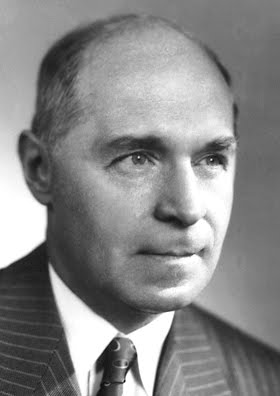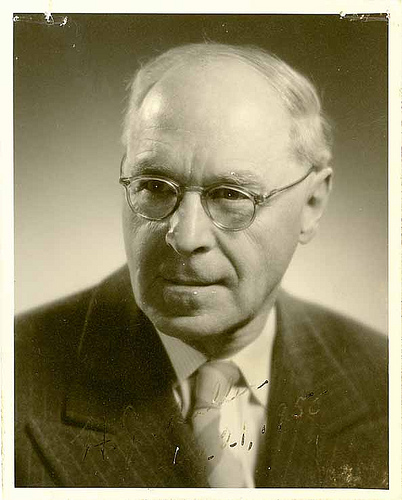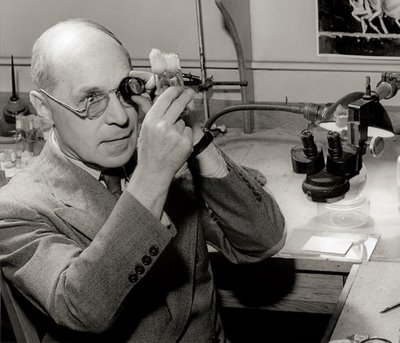<Back to Index>
- Geneticist Hermann Joseph Muller, 1890
- Composer Zdeněk Fibich, 1850
- President of the Colony of Rhode Island and Providence Plantations Roger Williams, 1603
PAGE SPONSOR



Hermann Joseph Muller (or H. J. Muller) (December 21, 1890 – April 5, 1967) was an American geneticist, educator, and Nobel laureate best known for his work on the physiological and genetic effects of radiation (X-ray mutagenesis) as well as his outspoken political beliefs. Muller frequently warned of the long term dangers of radioactive fallout from nuclear war and nuclear testing, helping to raise public awareness in this area. He was also the first to describe what since has become termed "irreducible complexity", which has been used as an argument in favor of "intelligent design" by creationists opposed to the theory of evolution. Muller did not find any contradictions between "irreducible complexity" and evolution, but described the phenomenon as the result of evolution.
Muller was born in New York City and excelled in the public schools. As an adolescent, he attended a Unitarian church and considered himself a pantheist; in high school he became an atheist. At 16 he entered Columbia College. From his first semester he was interested in biology; he became an early convert of the Mendelian - chromosome theory of heredity — and the concept of genetic mutations and natural selection as the basis for evolution. He formed a Biology Club and also became a proponent of eugenics; the connections between biology and society would be his perennial concern. Muller earned a B.A. degree in 1910.
Muller remained at Columbia (the pre-eminent American zoology program at the time, thanks to E.B. Wilson and his students) for graduate school. He became interested in the Drosophila genetics work of Thomas Hunt Morgan's fly lab after undergraduate bottle washers Alfred Sturtevant and Calvin Bridges joined his Biology Club. In 1911 - 1912, he studied metabolism at Cornell University, but remained involved with Columbia. He followed the drosophilists as the first genetic maps emerged from Morgan's experiments, and joined Morgan's group in 1912 (after two years of informal participation).
In
the fly group, Muller's contributions were primarily theoretical:
explanations for experimental results and ideas and predictions for new
experiments. In the emerging collaborative culture of the drosophilists,
however, credit was assigned based on results rather than ideas; Muller
felt cheated when he was left out of major publications.
In 1914, Julian Huxley offered Muller a position at the recently founded William Marsh Rice Institute, now Rice University; he hurried to complete his Ph.D. degree and moved to Houston for the beginning of the 1915 - 1916 academic year (his degree was issued in 1916). At Rice, Muller taught biology and continued Drosophila lab work. In 1918, he proposed an explanation for the dramatic discontinuous alterations in Oenothera larmarckiana that were the basis of Hugo de Vries's theory of mutationism: "balanced lethals" allowed the accumulation of recessive mutations, and rare crossing over events resulted in the sudden expression of these hidden traits. In other words, de Vries's experiments were explainable by the Mendelian - chromosome theory. Muller's work was increasingly focused on mutation rate and lethal mutations. In 1918, Morgan — short - handed because many of his students and assistants were drafted for the U.S. entry into World War I — convinced Muller to return to Columbia to teach and to expand his experimental program.
At Columbia, Muller and his collaborator and longtime friend Edgar Altenburg continued the investigation of lethal mutations. The primary method for detecting such mutations was to measure the sex ratios of the offspring of female flies. They predicted the ratio would vary from 1:1 due to recessive mutations on the X chromosome, which would only be expressed in males (who lacked the functional allele on a second X chromosome). Muller found a strong temperature dependence in mutation rate, leading him to believe that spontaneous mutation was the dominant mode (and to initially discount the role of external factors such as ionizing radiation or chemical agents). In 1920, Muller and Altenburg coauthored a seminal paper in Genetics on "modifier genes" that determine the size of mutant Drosophila wings. In 1919, Muller made the important discovery of a mutant (later found to be a chromosomal inversion) that appeared to suppress crossing - over, which opened up new avenues in mutation rate studies. However, his appointment at Columbia was not continued; he accepted an offer from the University of Texas and left Columbia after the summer of 1920.
Muller taught at The University of Texas from
1920 until 1932. Soon after returning to Texas, he married mathematics
professor Jesse Marie Jacobs, whom he had courted previously. In his
early years at Texas, Muller's Drosophila work was slow going; the data from his mutation rate studies were difficult to interpret. In 1923, he began using radium and X-rays,
but the relationship between radiation and mutation was difficult to
measure because such radiation also sterilized the flies. In this
period, he became more involved with eugenics and human genetics. He
carried out a study of twins separated at birth that seemed to indicate a
strong hereditary component to I.Q. Muller
was critical of the new directions of the eugenics movement (such as
anti - immigration), but was hopeful about the prospects for positive
eugenics.
1926 marked the beginning of a series of major breakthroughs. Beginning in November, Muller carried out two experiments with varied doses of X-rays, the second of which used the crossing over suppressor stock ("ClB") he had found in 1919. A clear, quantitative connection between radiation and lethal mutations quickly emerged. Muller's discovery created a media sensation after he delivered a paper entitled "The Problem of Genetic Modification" at the Fifth International Congress of Genetics in Berlin; it would make him one of the better known public intellectuals of the early 20th century. By 1928, others had replicated his dramatic results, expanding them to other model organisms such as wasps and maize. In the following years, he began publicizing the likely dangers of radiation exposure in humans (such as physicians who frequently operate X-ray equipment).
His lab grew quickly, but it shrunk again following the onset of the Great Depression. Especially after the stock market crash, Muller was increasingly pessimistic about the prospects of capitalism. Some of his visiting lab members were from the USSR, and he helped edit and distribute an illegal leftist student newspaper, The Spark.
It was a difficult period for Muller both scientifically and
personally: his marriage was falling apart, and he was increasingly
dissatisfied with his life in Texas. Meanwhile, the waning of the
eugenics movement, ironically hastened by his own work pointing to the
previously ignored connections between environment and genetics, meant
that his ideas on the future of human evolution had reduced impact in
the public sphere.
In September 1932, Muller moved to Berlin to work with the Russian expatriate geneticist Nikolay Timofeeff - Ressovsky; a trip intended as a limited sabbatical stretched into an eight year, five country journey. In Berlin, he met two physicists who would later be significant to the biology community: Niels Bohr and Max Delbrück. The Nazi movement was precipitating the rapid emigration of scientific talent from Germany, and Muller was particularly opposed to the politics of National Socialism. But the FBI was investigating Muller because of his involvement with The Spark, so he chose instead to go to the Soviet Union (an environment better suited to his political beliefs). In 1933, Muller and his wife reconciled, and she and their son David E. Muller moved with Hermann to Leningrad. There, at the Institute of Genetics, he imported the basic equipment for a Drosophila lab — including the flies — and set up shop. The Institute was moved to Moscow in 1934, and Muller and his wife were divorced in 1935.
In the USSR, Muller supervised a large and productive lab, and organized work on medical genetics. Most of his work involved further explorations of genetics and radiation. There he completed his eugenics book, Out of the Night. By 1936, however, Joseph Stalin's repressive policies and the rise of Lysenkoism was making the USSR an increasingly problematic place to live and work. Muller and much of the Russian genetics community did what they could to oppose Trofim Lysenko and his Larmarckian evolutionary theory, but Muller was soon forced to leave the Soviet Union after Stalin read a translation of his eugenics book and was "displeased by it, and... ordered an attack prepared against it."
Muller — with about 250 strains of Drosophila — moved to Edinburgh in September 1937, after a brief stay in Madrid and Paris.
In 1938, with war on the horizon, he began looking for a permanent
position back in the United States. He also began courting Dorothea
"Thea" Kantorowicz, a German refugee; they were married in May 1939. The
Seventh International Congress on Genetics was held in Edinburgh later
that year; Muller wrote a "Geneticists' Manifesto" in
response to the question: "How could the world's population be improved
most effectively genetically?" He also engaged in a debate with the
perennial genetics gadfly Richard Goldschmidt over the existence of the gene, for which there remained little direct physical evidence.
When Muller returned to the United States in 1940, he took an untenured research position at Amherst College, in the department of Otto Glaser. After the U.S. entry into World War II, his position was extended indefinitely and expanded to include teaching. His Drosophila work in this period focused on measuring the rate of spontaneous (as opposed to radiation induced) mutations. Muller's publication rate decreased significantly in this period, from a combination of lack of lab workers and experimentally challenging projects. However, he also worked as an adviser to the Manhattan Project (though he did not know that was what it was), as well as a study of the mutational effects of radar. Muller's appointment was ended after the 1944 – 1945 academic year, and despite difficulties stemming from his socialist political activities, he found a position as professor of zoology at Indiana University. Here, he lived in a Dutch Colonial Revival house in the city's Vinegar Hill neighborhood which his grandson reports he bought with his Nobel Prize money.
In 1946 Muller was awarded the Nobel Prize in Physiology or Medicine, "for the discovery that mutations can be induced by x-rays". Genetics, and especially the physical and physiological nature of the gene, was becoming a central topic in biology, and x-ray mutagenesis was a key to many recent advances — among them, George Beadle and Edward Tatum's work on Neurospora that established the one gene - one enzyme hypothesis.
The Nobel Prize, in the wake of the atomic bombings of Hiroshima and Nagasaki, focused public attention on a subject Muller had been publicizing for two decades: the dangers of radiation. In 1952, nuclear fallout became a public issue; since Operation Crossroads, more and more evidence had been leaking out about radiation sickness and death caused by nuclear testing, and Muller was one of the foremost experts. Muller — and many other scientists — pursued an array of political activities to defuse the threat of nuclear war. With the Castle Bravo fallout controversy in 1954, the issue became even more urgent. In 1955 Muller was one of eleven prominent intellectuals to sign the Russell - Einstein Manifesto, the upshot of which was the first Pugwash Conference on Science and World Affairs in 1957, which addressed the control of nuclear weapons. He was a signatory (with many other scientists) of the 1958 petition to the United Nations, calling for an end to nuclear weapons testing, which was initiated by the Nobel Prize winning chemist Linus Pauling.
He was awarded the Linnean Society of London's prestigious Darwin - Wallace Medal in 1958.
H. J. Muller and science fiction writer Ursula Le Guin were second cousins; his father (Hermann J. Muller Sr.) and her father's mother (Johanna Muller Kroeber) were siblings, the children of Nicholas Müller who immigrated to the United States in 1848. Another cousin was Herbert J. Muller, whose grandfather Otto was another son of Nicholas and a sibling of Hermann Sr. and Johanna.
Muller
is survived by his daughter, Helen J. Muller, an Emeritus professor
at the University of New Mexico, who had a daughter, Mala Htun. His
son, David E. Muller, an Emeritus professor of mathematics at the
University of Illinois and at New Mexico State University, died in 2008
in Las Cruces, New Mexico. His children are Chandra L. Muller and
Kenneth J. Muller. Dorothea Kantorowicz Muller was Helen Muller's
mother, and Jessie Jacobs Muller Offermann was David Muller's mother.
David E. Muller was the inventor of the Muller C-element, a device used to implement asynchronous circuitry in electronic computers.
